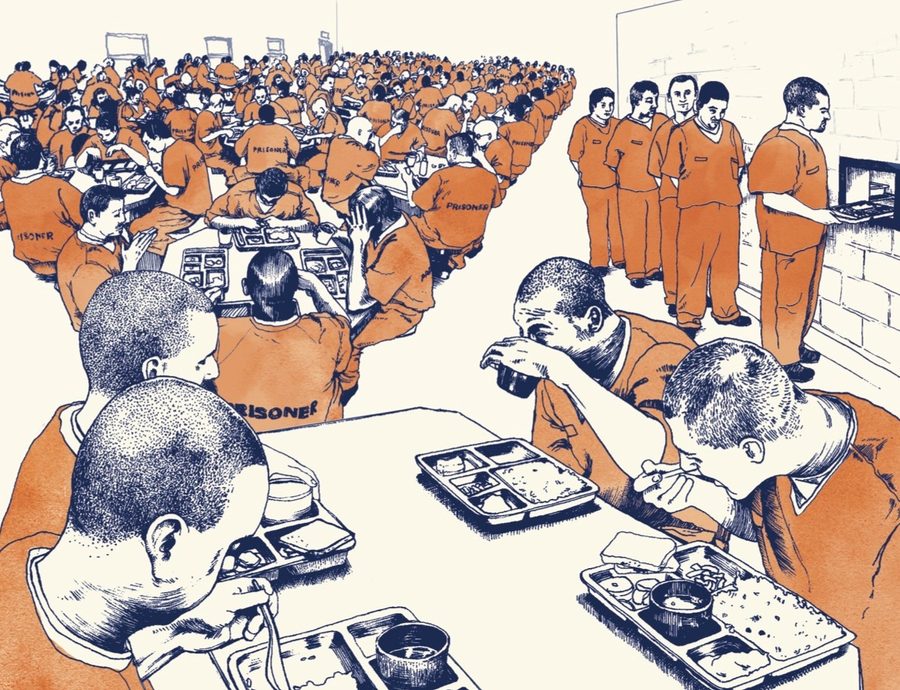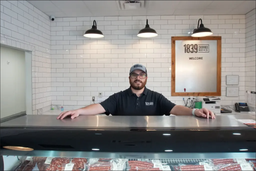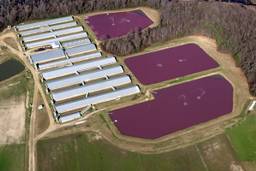Bad Prison Food Can Cause Health Problems that Linger After Release
Due to unhealthy food, people in prisons and jails experience high rates of diabetes, heart disease, mental health issues and illnesses related to foodborne pathogens.
Lela Nargi

Editor’s Note: This story was originally published by The Counter, a non-profit newsroom covering the forces shaping how and what we eat. It is republished here by permission.
For the four years Heile Gantan was behind bars in California, she experienced frequent hunger.
To lessen its pangs, she filled up on packets of dry oatmeal she purchased in the commissary, with “no water, no milk, no anything. It was really just filler food. That was a constant theme throughout my incarceration: How can I fill up my stomach?”
Deprivation turned into bingeing. She thought, “‘Okay, I’m going to consume all the [cereal] I can get my hands on, so I’m not hungry when I go to sleep.’”
That became an unfortunate pattern — one she brought home after finishing her sentence. Back with her family, she stuffed herself with bread and also began hoarding, fearful that she wouldn’t have all the food she wanted or needed. “That habit was really hard for me to break, the thought of, ‘I may not have this tomorrow,’” she said.
Gantan is now a research fellow with Impact Justice (IJ), a justice-reform nonprofit. Over a span of 18 months, the organization researched and surveyed 250 formerly incarcerated people in 41 states, family members, and prison employees for a November 2020 report that detailed the disordered eating and other effects of insufficient diets that people experience while serving time. Those effects can linger well after people are released.
Served up in too-scant portions or even withheld, food in jails and prisons can instigate or exacerbate diet-related health issues, coping behaviors, and food insecurity that are already prevalent among communities of color that bear the brunt of mass incarceration.
The abysmal quality of food in carceral settings is well-documented. High in sodium and sugar, the diet in our nation’s jails and prisons is severely lacking in healthy foods. More often than not, it’s carb-heavy and ultra-processed fare. It’s also frequently rotten, moldy, or vermin-infested. And there’s rarely enough of the food to appropriately nourish. As a result, “a positive relationship with food — an essential part of being human — is denied every day to incarcerated people,” wrote the IJ report authors.
Due to unhealthy food, people within the carceral system experience high rates of diabetes and heart disease; mental health and behavior issues; and illnesses due to foodborne pathogens.
They’re also subject to outright hunger; 94 percent of formerly incarcerated people surveyed by IJ said they could not eat enough to feel full, a finding supported by a 2018 report by the Incarcerated Workers Organizing Committee. Hunger is often mitigated only for those, like Gantan, who can afford to purchase items in the commissary — two-fifths of those surveyed by IJ — where prices are often steeply inflated and out-of-reach to incarcerated people making cents per hour at their in-prison jobs.
“The food [in prison] is designed to slowly break your body and mind,” one formerly incarcerated person said in the report. Because a large number of people within the system are eventually released—650,000 each year among the 2.5 million people held annually—lead author Leslie Soble and her co-authors argue that the physical and mental health of returning citizens should be “a community and societal concern.”
That’s not the reality. After release, people convicted of some offenses, like drug-related felonies, are banned from receiving SNAP (popularly known as food stamps) and other food benefits; 91 percent of re-entering people report experiencing food insecurity, and many experienced hunger before that. For these populations, prison manifests as one stop along a continuum of hunger and food trauma, where the message is, said Soble, “You are not worthy of care or good health. You are disposable.”
Unlike many people in U.S. jails and prisons, Gantan came from a home in which there was plenty of food home-cooked by her Filipino-American parents and grandparents. “I never experienced food insecurity before my time in the system,” she said, describing prison meals as “looking like slop for an animal.” Meals like “slimy” bologna and white bread alongside a few potato chips and a packet of mustard are common; some formerly incarcerated people report being served food intended for livestock.
Kanav Kathuria, founder of the Maryland Food & Prison Abolition Project (Food & Abolition), said that prisons are an extension of racialized segregation, and carceral food “is a tool of control and dehumanization and violence.” But even within the carceral system, there’s a hierarchy of awfulness.
Gantan says she was served higher-quality food when she signed up for fire camp, clearing brush in city parks and fighting local fires. Fresh fruits and vegetables, a rarity in jails and prisons, were more available. And meals were eaten immediately after being prepared rather than being pre-cooked and then reheated, which improved overall quality.
But fire camp “was where I experienced the most food insecurity,” Gantan said. “I remember vividly, we’d had a sack lunch at 12 in the afternoon. Then we got called to a fire and didn’t receive our next meal until 4 in the morning. You need energy, and power, and also motivation, and not knowing when your next meal is going to come you wonder, ‘How am I going to sustain myself?’”
Bingeing and hoarding allow those who are imprisoned to assert some scant control over their lives, said Taylar Nuevelle. Nuevelle spent four and a half years in federal prisons and later founded Who Speaks for Me?, a nonprofit that advocates for women, girls, and LGBTQ people of color affected by the justice system.
Her method of control was to restrict her eating, a technique she’d already adopted growing up in an abusive and food-insecure home, then in foster care. “I learned not to be hungry,” she said. “With the further punishment of incarceration, I reverted back to my old coping skills of not eating.”
Nuevelle believes that the worst food is served in county jails. There, she said, it’s distinguished not just by how bad it is, but by the fact that it’s served through a slot into the same space “where you eat and sleep and poop. That’s just inhumane.” Solitary confinement may feature even worse food; in some places, those in solitary are served a purposefully disgusting protein-rich, tasteless concoction called nutraloaf. Rapid and dramatic weight loss can occur, which can lead to severe dehydration, gallstones, cardiovascular disease, and tooth loss from malnutrition.
While in a medium-security prison in West Virginia, Nuevelle “erred on the side of anorexia.” She notes, too, that many other women she served time with exhibited trauma-induced behaviors: hoarding, drinking coffee all day to suppress appetite, “eating and eating and eating,” and bingeing and purging.
Weight gain is an even bigger challenge than weight loss for many; Nuevelle calls the bellies of women who eat the high-starch meals off the chow hall trays “‘tray babies.’ It’s not uncommon for women to gain 70 pounds. You literally watch their bodies grow.”
Before her time in that West Virginia facility, Nuevelle spent two years in a federal prison camp some 200 miles south called Alderson — the facility where Martha Stewart served time in 2004 and that’s considered swank by prison standards. “My first Thanksgiving there, I couldn’t believe it. We had turkey, and they gave us ham and green beans and collard greens,” Nuevelle said. “At Christmas, we had Cornish hens and shrimp, and there was real cutlery and salt and pepper shakers.”
Corrections departments often claim that better food is financially beyond their means. In 2016, California spent $3.14 per day per inmate while in Texas in 2019, 4 percent of the corrections budget went to carceral food. But the example of Alderson “tells you that there is a baseline for doing better, and the only reason that [Alderson] is the way it is is because the people that come there were not society’s undesirables before they went to prison,” Nuevelle said, referring to the fact that the Alderson tends to house people accused of white-collar crimes.
Wayne Williams was actually able to learn more about nutrition during the 35 years he was imprisoned in federal prisons. Today, he’s project coordinator at the Food Trust in Philadelphia, which offers trauma-informed nutrition education, shopping, and cooking classes for the formerly incarcerated. He remembers the poor-quality carceral meals as well as the preponderance of “junk” like ramen noodles from the commissary. His journey to more healthful eating started with “looking at the deterioration of other inmates’ health, [which] began to cause me to be concerned, like sugar, diabetes, high blood pressure. I didn’t want to take medicine,” he said. “So I started paying more attention to what I was eating.”
He read magazines such as Men’s Health and swapped nutritional information with other men he was serving time with; that information formed the basis of the work he does now with people returning home after incarceration.
Trauma-informed nutrition education goes beyond simple cooking classes and connections to food resources. It addresses mental and emotional wellness, with an eye toward how stressful and traumatic experiences can shape a person’s relationship to food, and the ways in which shame, anxiety, and tension around eating can be reduced, according to Leah’s Pantry, a San Francisco nonprofit that trains nutrition ed facilitators.
This kind of education can be a long haul and requires those who offer it to understand the wider implications of trauma. “I had to broaden ‘nutrition education’ to the idea of a better quality of life and connect it with, not just physical health, but mental health, spiritual health,” Williams said.
He starts by telling those who take his six-week class that he shares their experience within the system, in order to forge trust. Afterward, he aims to stay connected with them as a mentor, helping them sign up for SNAP benefits, referring them to health clinics where they can receive additional nutrition counseling.
“Eating healthy helps me to have a healthy attitude and value my own life,” Williams said. “When you are concerned about what you eat, then you’re concerned about yourself. That’s the beginning [of healing]; you’re not thinking short term anymore.”
After she returned home from prison, Gantan gained a lot of weight as she attempted to navigate her bingeing and hoarding. “I had to get back into the motion of meal planning. Once I was able to lay out what I was going to eat, and how much [food] do I need for these meals, it helped me put down the extra box of pancake mix and think, ‘Okay, I don’t really need [this] because [it’s] going to be there the next time.’”
Now studying for a master’s degree in public policy, she sees benefit in connecting the formerly incarcerated with things like CalFresh — California’s version of SNAP, which matches $10 worth of fresh produce purchases per month (notably, California has lifted the SNAP ban for those with drug felonies). She wants to see people who are coming up for parole automatically given CalFresh signup sheets and lists of other food resources, in addition to trauma-informed nutrition ed.
Nuevelle would like to see initiatives start much, much earlier. “At the federal level, [prisons] have residential drug-abuse programs. Can you imagine if we had trauma treatment programs in carceral spaces?” she said. For that matter, “what would it look like if, right from the moment you get arrested, [judges and lawyers] asked, ‘What is it that this person really needs?’ And nine times out of 10, it’s not going to be incarceration; it’s going to be trauma treatment.”
At Food & Abolition, Kathuria works to abolish the carceral system outright. But in the meantime, the organization is aiming to connect prisons and jails with urban and small-scale farms. It hopes the farms provide more nutritious food to those who are incarcerated and also meaningful, sustaining jobs, to those coming back to their communities. A pilot project to do just this was waylaid due to the pandemic.
“A person going into prison, even if they’re healthy, is likely going to leave with chronic health conditions, whether physical or mental,” Kathuria said. “What are the implications of that amongst the millions of folks who are incarcerated in this country every year? How do you even measure that impact?”
Lela Nargi is a veteran journalist covering food policy and agriculture, sustainability, and science for outlets such as the Washington Post, JSTOR Daily, Sierra, Ensia, and Civil Eats. Find her at lelanargi.com.




